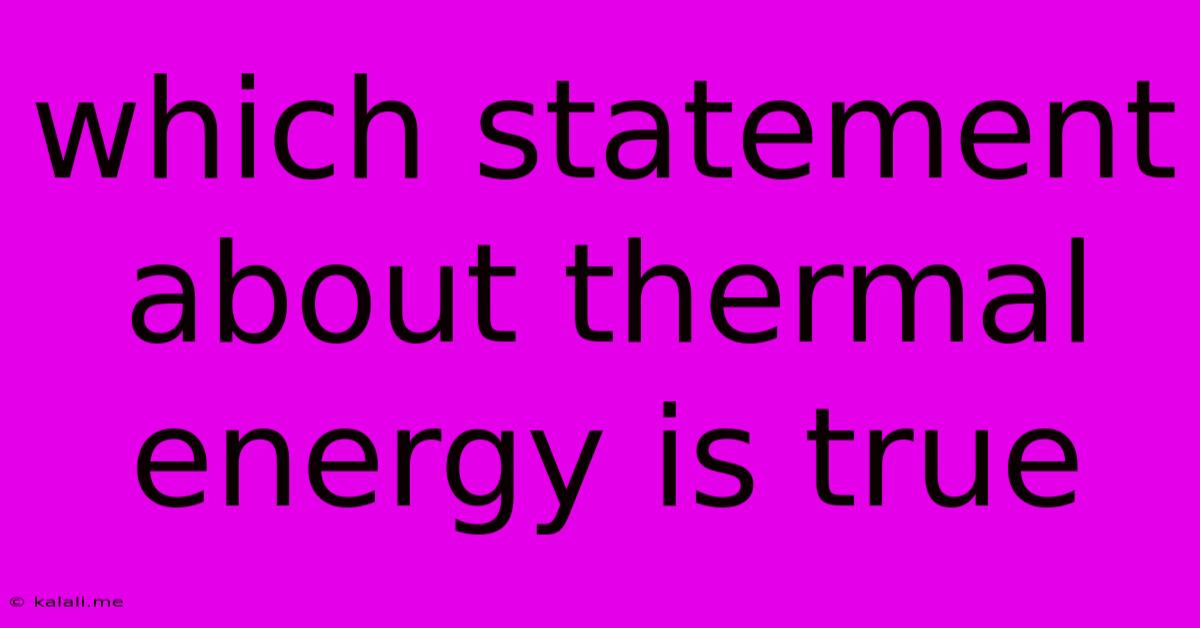Which Statement About Thermal Energy Is True
Kalali
Jun 13, 2025 · 3 min read

Table of Contents
Which Statement About Thermal Energy is True? Deconstructing Heat and Temperature
Understanding thermal energy is crucial for grasping many scientific concepts, from weather patterns to engine efficiency. This article will delve into the nuances of thermal energy, clarifying common misconceptions and ultimately answering the question: which statement about thermal energy is true? We'll explore several common statements and analyze their accuracy, providing a clear and concise understanding of this fundamental concept.
What is Thermal Energy? Thermal energy is the total kinetic energy of the particles (atoms and molecules) within a substance. It's essentially a measure of the internal energy of a system due to the random motion of its constituent particles. This motion is directly related to temperature, but they are not interchangeable. Temperature is the average kinetic energy of these particles, while thermal energy considers the total kinetic energy. This subtle difference is often the source of confusion.
Let's examine some common statements about thermal energy and determine their validity:
Common Statements about Thermal Energy: Fact or Fiction?
Here are some typical statements about thermal energy, categorized as true or false, along with explanations:
Statement 1: Thermal energy and temperature are the same thing.
FALSE. As explained above, thermal energy is the total kinetic energy of particles, whereas temperature represents the average kinetic energy. A large object at a low temperature can have more thermal energy than a small object at a high temperature. Think of a bathtub full of lukewarm water compared to a cup of boiling water – the bathtub, despite being cooler, contains significantly more thermal energy.
Statement 2: Thermal energy always flows from hotter objects to colder objects.
TRUE. This is a fundamental principle of thermodynamics, known as the second law of thermodynamics. Heat transfer, driven by the difference in temperature, always occurs spontaneously from a region of higher temperature to a region of lower temperature. This continues until thermal equilibrium is reached, where both objects have the same temperature. This principle governs processes like heat conduction, convection, and radiation.
Statement 3: Objects with higher temperatures always have more thermal energy.
FALSE. This is where the distinction between temperature and thermal energy becomes crucial. While a higher temperature generally implies higher average kinetic energy, the total thermal energy also depends on the mass of the object and the specific heat capacity of the material it’s made of. A small, very hot object might have less thermal energy than a large, cooler object.
Statement 4: Thermal energy can be transferred through conduction, convection, and radiation.
TRUE. These three methods describe the different ways thermal energy can be transferred:
- Conduction: Direct transfer of thermal energy through physical contact. Think of touching a hot stove.
- Convection: Transfer of thermal energy through the movement of fluids (liquids or gases). This is how ovens work, and how the Earth's atmosphere circulates heat.
- Radiation: Transfer of thermal energy through electromagnetic waves. The sun's warmth is a prime example of thermal energy transfer through radiation.
Statement 5: The thermal energy of an object is directly proportional to its mass.
TRUE. For a given substance at a constant temperature, the more mass it has, the more total thermal energy it possesses. More particles mean more kinetic energy, leading to a greater overall thermal energy.
Conclusion:
Understanding the difference between thermal energy and temperature is vital for correctly interpreting thermal phenomena. While temperature reflects the average kinetic energy, thermal energy represents the total kinetic energy of the particles within a system. Therefore, the most accurate statement among common assertions about thermal energy is that thermal energy always flows from hotter objects to colder objects, reflecting the fundamental principle of the second law of thermodynamics. Remember that the mass and specific heat capacity of an object also play critical roles in determining its total thermal energy.
Latest Posts
Latest Posts
-
What Is The Factor Of 70
Jun 14, 2025
-
How Many Bones In The Hand And Foot
Jun 14, 2025
-
The System Of Rules Governing Permissible Word Order In Sentences
Jun 14, 2025
-
How To Work Out Tensile Stress
Jun 14, 2025
-
Type Of Membrane That Forms The Skin
Jun 14, 2025
Related Post
Thank you for visiting our website which covers about Which Statement About Thermal Energy Is True . We hope the information provided has been useful to you. Feel free to contact us if you have any questions or need further assistance. See you next time and don't miss to bookmark.